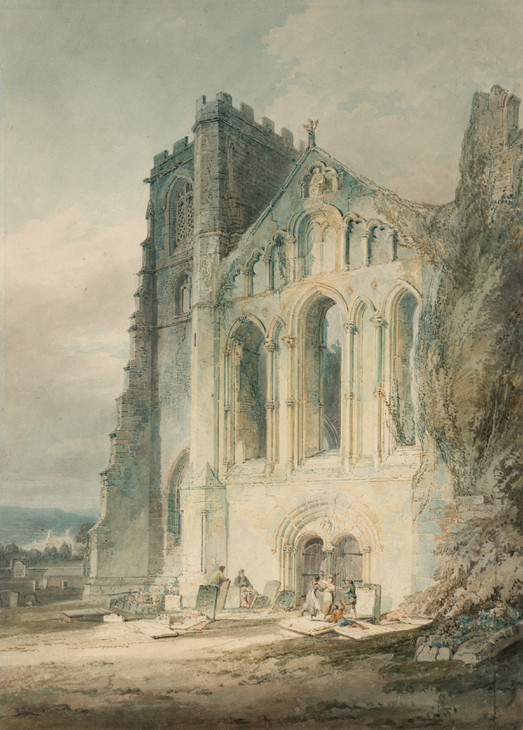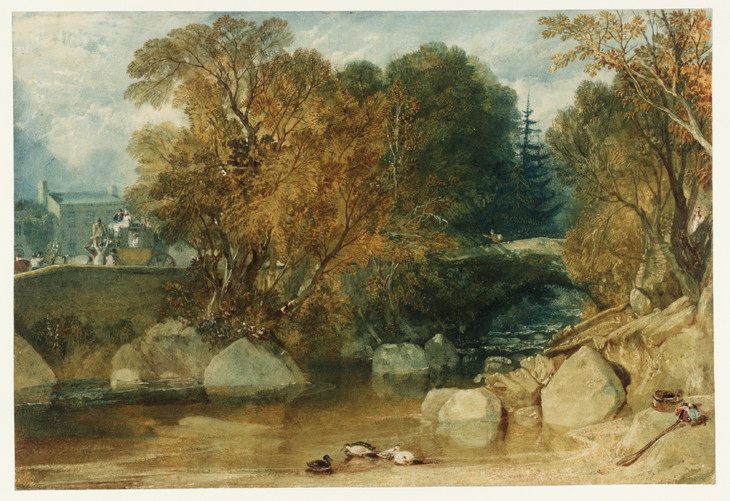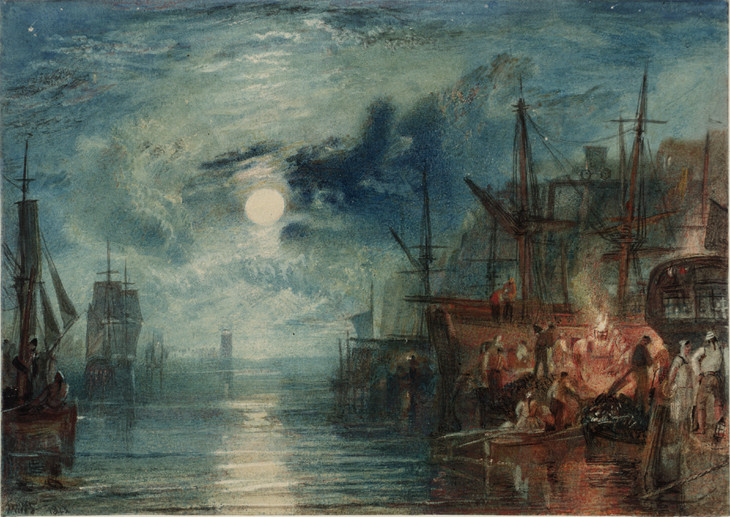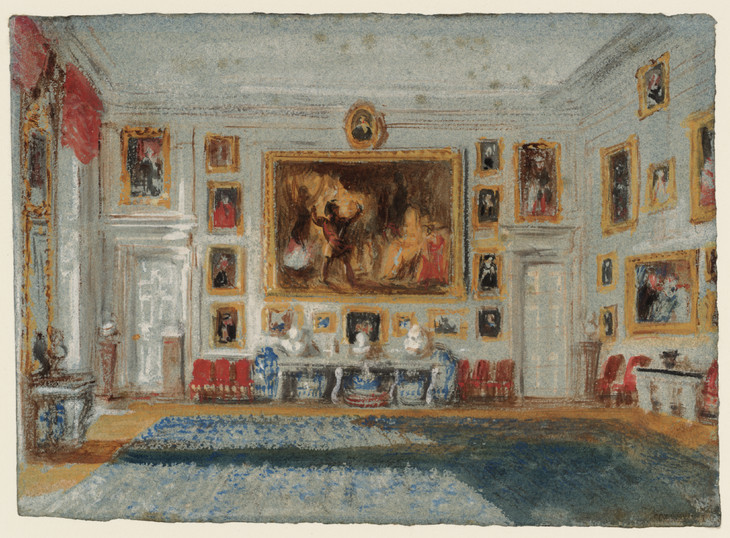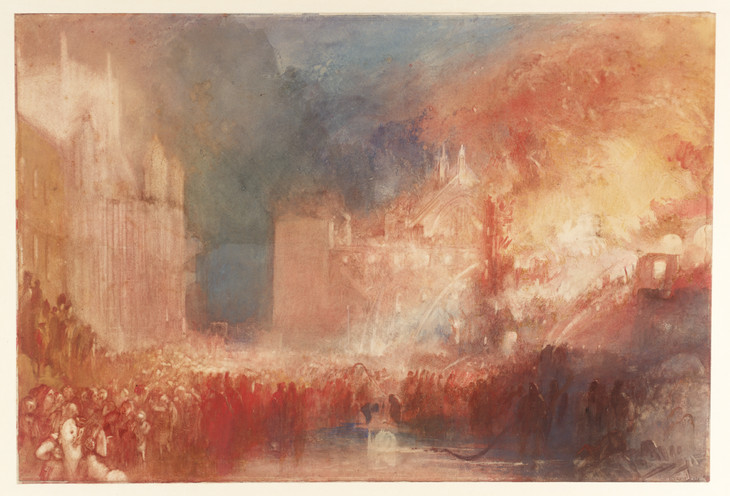Chronology
1775
23 April: Joseph Mallord William Turner born, 21 Maiden Lane, Covent Garden, London.
14 May: baptised at St Paul’s, Covent Garden.
1785
Stays with an uncle at Brentford, Middlesex, where he attends school.
1786
Stays at Margate, where has further schooling; earliest drawings.
1787
First signed and dated drawings; his father displays his work at his barber’s shop.
1789
Stays with an uncle at Sunningwell near Oxford.
Employed as a draughtsman by the architect Thomas Hardwick and later by the artist Thomas Malton, ‘my real master’.
11 December: enters Royal Academy Schools after a term’s probation.
1790
Moves with his family to Hand Court, 26 Maiden Lane, Covent Garden.
Exhibits first watercolour at the Royal Academy.
1791
Exhibits two watercolours at the Royal Academy.
Visits John Narraway, a friend of his father, at Bristol and tours to Bath and Malmesbury.
1792
Graduates to the Royal Academy life class and exhibits two watercolours.
Meets John Soane and W.F. Wells, who will become lifelong friends.
Revisits the Narraways; tours South Wales.
1793
Awarded Greater Silver Palette by the Royal Society of Arts for a landscape drawing.
Summer, visits Hereford and Tintern.
Autumn, visits Kent and Sussex.
First documented contact with Dr Thomas Monro.
Thought to make first attempts at painting in oil.
1794
Exhibits five watercolours at the Royal Academy.
Summer, tours Midlands and North Wales.
Gives drawing lessons and begins working with Thomas Girtin at the Monro.
‘Academy’ copying drawings by J.R. Cozens and other artists.
1795
Exhibits eight watercolours at the Royal Academy.
June–July: tours South Wales.
August–September: visits Isle of Wight.
Receives commissions from John Landseer, Viscount Malden (later Earl of Essex) and Sir Richard Colt Hoare.
1796
Exhibits first oil painting and ten watercolours at the Royal Academy.
Summer, thought to visit Brighton to convalesce from illness.
1797
Exhibits two oils and four watercolours at the Royal Academy.
Summer, tours North of England and Lake District and visits Harewood, Yorkshire, to work for Edward Lascelles.
1798
Exhibits four oils and six watercolours at the Royal Academy
April: short sketching tour in Kent with the Revd Robert Nixon and Stephen Rigaud.
Summer: tours Wales.
Competes (underage) and is not elected as Associate of the Royal Academy.
1799
Exhibits four oils and seven watercolours at the Royal Academy.
Recommended to Lord Elgin as his draughtsman in Greece but does not accept his terms; the Italian Giovanni Battista Lusieri is appointed instead.
Visits William Beckford in London and (in August–September) Fonthill, Somerset.
October: visits North Wales, and Knockholt, Kent.
4 November: elected A.R.A.
Moves to 64 Harley Street, sharing a studio with J.T. Serres.
First Oxford Almanack illustration, engraved by James Basire, published.
1800
31 March: George Dance draws his portrait.
Exhibits two oils and six watercolours at the Royal Academy.
The future Duke of Bridgewater commissions Dutch Boats in a Gale or ‘The Bridgewater Seapiece’ (private collection) as a companion to his picture by Willem van de Velde the younger.
27 December: his mother is admitted to Bethlem Hospital for the insane.
1801
Exhibits two oils and four watercolours at the Royal Academy.
June–August: tours Scotland via Lake District and Chester.
1802
12 February: elected Royal Academician.
Exhibits eight works, mainly oils, at the Royal Academy and sells his first picture to Lord Egremont.
15 July–October: tours France, Savoy and Switzerland and spends three weeks in Paris, studying pictures in the Louvre; the trip is sponsored by a consortium of noblemen and he is accompanied by Newbey Lowson as ‘paymaster’.
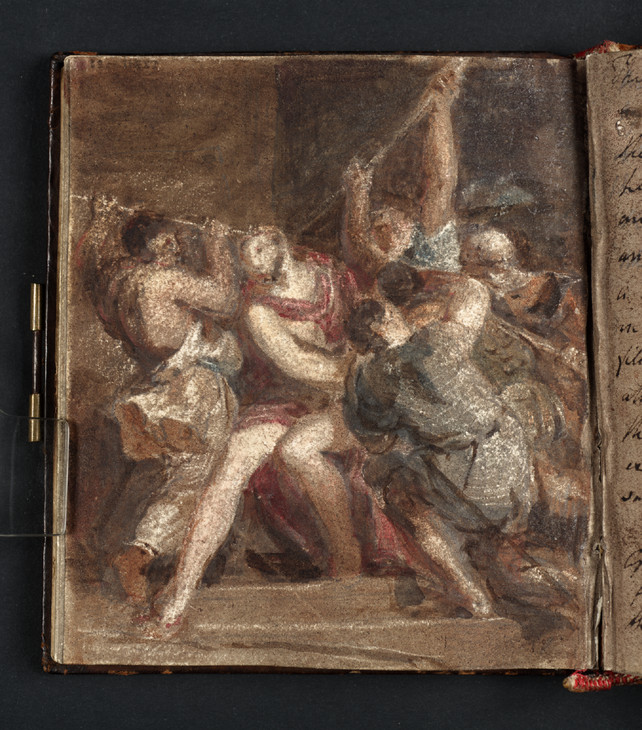
Joseph Mallord William Turner 1775–1851
Christ Crowned with Thorns, after Titian 1802
Graphite on paper
support: 128 x 114 mm
Tate D04340
Accepted by the nation as part of the Turner Bequest 1856
Joseph Mallord William Turner
Christ Crowned with Thorns, after Titian 1802
Tate D04340

Joseph Mallord William Turner 1775–1851
Commentary on Titian's 'Christ Crowned with Thorns' (Inscription by Turner) 1802
Graphite on paper
support: 128 x 114 mm
Tate D04339
Accepted by the nation as part of the Turner Bequest 1856
Joseph Mallord William Turner
Commentary on Titian's 'Christ Crowned with Thorns' (Inscription by Turner) 1802
Tate D04339
1803
Exhibits five oils and two watercolours at the Royal Academy and serves on Academy Council and Hanging Committee.
Sells his first work to Walter Fawkes, who becomes a close friend and patron.
His pictures attract criticism from Sir George Beaumont, an amateur painter and influential arbiter of taste.
1804
15 April: his mother dies, probably at Bethlem Hospital.
18 April: opens Turner’s Gallery on the corner of Harley Street and Queen Anne Street, showing oils and watercolours.
Exhibits two oils and one watercolour at the Royal Academy.
1805
Shows no work at the Royal Academy and concentrates on his own gallery.
Stays at Sion (Syon) Ferry House, Isleworth and tours River Thames and Wey Navigation by boat, sketching from nature in watercolour and oil.
Late December, sketches the Victory when she returns to the River Medway after the Battle of Trafalgar (21 October).
1806
Exhibits one oil and one watercolour at the Royal Academy, two oils at the new British Institution, and oils and watercolours at Turner’s Gallery.
Summer, visits W.F. Wells at Knockholt, Kent, who encourages him to begin working on the Liber Studiorum (examples of characteristic types of landscape to be published as prints).
Late this year, takes 6 West End, Upper Mall, Hammersmith as an out-of-town retreat, to replace Sion Ferry House.
1807
1 January: The Shipwreck, the first print after one of his pictures, by Charles
Turner (no relation) is published.
Turner (no relation) is published.
Buys land at Twickenham.
Exhibits Thames views (‘crude blotches’ according to the Royal Academy’s
President, Benjamin West) at Turner’s Gallery, and two oils at the Royal
Academy; both are bought by Sir John Leicester, who is forming a gallery of
modern art, but are later sold.
President, Benjamin West) at Turner’s Gallery, and two oils at the Royal
Academy; both are bought by Sir John Leicester, who is forming a gallery of
modern art, but are later sold.
11 June: first number of the Liber Studiorum is published.
Summer: at Cassiobury Park, Hertfordshire, to draw it for the Earl of Essex (formerly Viscount Malden).
November: at Spithead, to witness arrival of Danish ships taken at Copenhagen.
2 November: elected Professor Perspective at the Royal Academy. Will sometimes add ‘P.P’ to his signature.
1808
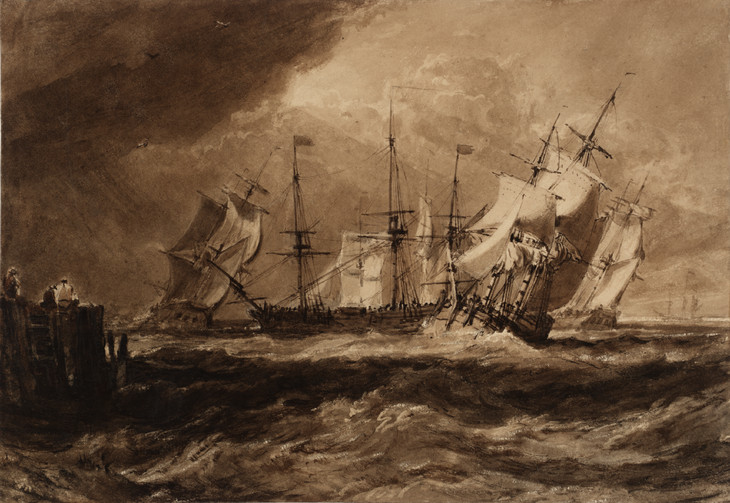
Joseph Mallord William Turner 1775–1851
Ships in a Breeze ('The Egremont Sea Piece') c.1806–7
Graphite and watercolour on paper
support: 184 x 262 mm
Tate D08114
Accepted by the nation as part of the Turner Bequest 1856
Joseph Mallord William Turner
Ships in a Breeze ('The Egremont Sea Piece') c.1806–7
Tate D08114
Summer, visits Sir John Leicester to paint his seat, Tabley House, Knutsford, Cheshire, visits Wales and the River Dee and (in August) Farnley Hall, near Otley, Yorkshire, the seat of Walter Fawkes, for the shooting.
1809
Exhibits four oils, including two of Tabley, at the Royal Academy, one (earlier) picture at the British Institution and sixteen oils and two watercolours at Turner’s Gallery.
Summer, visits Petworth, Sussex and Cockermouth Castle, Cumberland to paint them for Lord Egremont; also visits Lowther Castle, Penrith, and Whitehaven Castle, seats of Lord Lonsdale.
November: commissioned by James Wyatt of Oxford for a picture of the city, which he visits this winter.
1810
Exhibits three oils at the Royal Academy and ten at his gallery.
His London address changes to 47 Queen Anne Street West.
Early summer, visits Rosehill (now Brightling) Park, Sussex, to make watercolours and a painting for John Fuller.
August: visits Farnley; returns every year until 1824.
1811
7 January: gives first Perspective Lecture, preparation having been delayed.
8 January: proposes a Chair of Landscape at the Royal Academy.
Exhibits four oils and five watercolours at the Academy; closes Turner’s Gallery for improvements.
July–September: tours West Country to collect subjects for W.B. Cooke’s
Picturesque Views on the Southern Coast of England, topographical prints to be issued in parts.
1812
January–February: gives six Perspective Lectures.
Reopens his Turner’s Gallery.
Exhibits four oils at the Royal Academy, one with first extract from his poem Fallacies of Hope.
Commences building Sandycombe Lodge, Twickenham, to his own designs.
1813
Gives no Perspective Lectures, perhaps needing time for revisions.
Exhibits two oils at the Royal Academy; serves as Visitor at Royal Academy Schools.
Completes Sandycombe Lodge, and commences visits.
Summer, tours Devon with Charles Eastlake, Cyrus Redding and Ambrose Johns, who encourage him to sketch in oil outdoors.
1814
January–February, gives more Perspective Lectures.
Exhibits one oil at the Royal Academy, reopens Turner’s Gallery and submits (late) a picture to a landscape competition at the British Institution, from which he is disqualified.
First instalments of Picturesque Views on the Southern Coast of England are published.
20 June: at Portsmouth sketches a review of the fleet held in the presence of the allied sovereigns, the Prince Regent, the King of Prussia and the Tsar of Russia.
1815
January, gives Perspective Lectures.
Exhibits four oils and four watercolours at Royal Academy and two works at Plymouth.
Summer: thought to visit Sussex and Kent.
28 November: Antonio Canova visits Turner’s Gallery.
1816
January: gives Perspective Lectures.
Exhibits two oils at the Royal Academy.
July–August: visits Yorkshire.
1817
Gives no Perspective Lectures.
Exhibits one oil at Royal Academy.
10 August–mid-September: tours Belgium and Holland including the site of the Battle of Waterloo (18 June 1815), and the Rhineland.
On return travels to Raby Castle to paint it for Lord Darlington, and completes fifty watercolours of the Rhine that he sells to Walter Fawkes on arriving for his regular visit to Farnley.
1818
January: gives Perspective Lectures.
Exhibits three oils and one watercolour at the Royal Academy.
Illustrates James Hakewill’s Picturesque Tour of Italy from on-the-spot drawings by the author.
October–November, visits Scotland to illustrate Walter Scott’s Provincial Antiquities of Scotland.
Begins rebuilding work on Turner’s Gallery.
1819
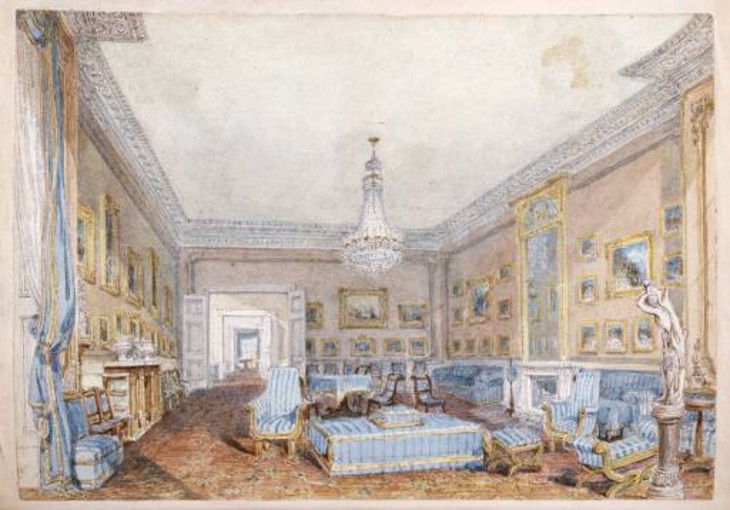
Joseph Mallord William Turner
Turner Drawing Room of 45 Grosvenor Place 1819
Watercolour and pen and ink on paper
support: 152 x 216 mm
Private collection
Photo: Turner Worldwide TW0266
Joseph Mallord William Turner
Turner Drawing Room of 45 Grosvenor Place 1819
Private collection
Photo: Turner Worldwide TW0266
January: final plates of the Liber Studiorum published. Gives Perspective Lectures.
March: eight of his pictures are hung in Sir John Leicester’s gallery at Hill Street, Mayfair.
Exhibits two oils at the Royal Academy.
May–June: sixty of his watercolours are displayed in an exhibition of Walter Fawkes’ collection at his house in Grosvenor Place.
August: sets out for Italy where he stays for six months, visiting Venice, Rome, Naples, Paestum and Florence.
November: proposed by Canova, is elected honorary member of the Academy of St Luke, Rome.
1820
1 February: returns to London.
April–June: Fawkes’s exhibition reopens.
Exhibits one painting, of Rome, at the Royal Academy.
1821
January–February: gives Perspective Lectures.
Does not exhibit at the Royal Academy.
April: W.B. Cooke exhibits numerous prints after his drawings, principally from Southern Coast.
Completes eight watercolours for Walter Scott’s Provincial Antiquities of Scotland; they are bought by Scott and hung at his Borders seat, Abbotsford
September:Visits Paris, Rouen and Dieppe for a series of views of the River Seine, to be engraved.
1822
Gives no Perspective Lectures.
February: W.B. Cooke exhibits watercolours, twenty-four by Turner, in Soho Square, London.
Exhibits only one oil at the Royal Academy but reopens Turner’s Gallery, hung mainly with earlier unsold works.
August: sails to Edinburgh to document King George IV’s visit.
August: sails to Edinburgh to document King George IV’s visit.
The King commissions a large picture of the Battle of Trafalgar for St James’s Palace.
1823
Exhibits one oil at the Royal Academy.
W.B. Cooke holds a second exhibition, with eleven Turner watercolours.
June: first plates of Cooke’s series Rivers of England, after Turner’s watercolours, published.
1824
Gives Perspective Lectures.
Does not exhibit at the Royal Academy but serves as auditor of its accounts.
W.B. Cooke holds a third exhibition, with fifteen Turner watercolours.
Summer: tours East Anglian coast for a proposed series of views, of which only a few will be published.
10 August–mid-September: tours Belgium, Luxembourg, Germany and northern France.
December: last visit to Farnley.
1825
Gives Perspective Lectures.
Exhibits one oil and one watercolour at the Royal Academy.
Begins preparing his most ambitious series of topographical watercolours for engraving, Picturesque Views in England and Wales, for Charles Heath.
August: tours Low Countries.
25 October: Walter Fawkes dies.
1826
Gives no Perspective Lectures.
Exhibits four oils at the Royal Academy.
Commissioned by Samuel Rogers to illustrate a new edition of his poem Italy.
Sells Sandycombe Lodge, having been unable to spend enough time there.
May: first part of Thomas Lupton’s series The Ports [formerly ‘Harbours’] of England, with plates after Turner’s watercolours, published.
Summer: tours northern France, Normandy, Brittany and the River Loire.
Thought to begin Little Liber mezzotints.
1827
Gives four Perspective Lectures.
Exhibits four or five oils at the Royal Academy.
7 July: buys back two pictures at the sale of the late Lord de Tabley (formerly Sir John Leicester).
July–early September: visits John Nash at East Cowes Castle, Isle of Wight, to paint two views and the Cowes regatta.
October: stays at Petworth.
1828
January–February: gives Perspective Lectures for the last time, but retains his post until 1837.
Exhibits four oils at the Royal Academy.
Visits Petworth to paint pictures for the Carved Room.
August: sets out for second visit to Italy.
October: reaches Rome, taking lodgings with Charles Eastlake at 12, Piazza Mignanelli.
December: exhibits recent works at the Palazzo Trulli where they are mocked, mainly by German artists.
1829
February: returns to London.
Exhibits three oils and one watercolour at the Royal Academy.
June–July: Charles Heath exhibits forty watercolours, many for England and Wales, at the Egyptian Hall, Piccadilly.
August–September: visits Paris, Normandy and Brittany and collects views of the River Seine.
21 September: his father dies.
29 September: his father is buried at St Paul’s, Covent Garden.
30 September: makes first will, providing for a Chair of Landscape at the Royal Academy and a gold Turner Medal for landscape painting; instructions for a picture gallery and almshouses to be built for ‘decayed English artists (landscape painters only) and single men’ on his land at Twickenham and two of his pictures to be hung with works by Claude at the National Gallery; and small family and personal legacies.
1830
7 January: attends the funeral of Sir Thomas Lawrence, late President of the Royal Academy, at St Paul’s Cathedral; his watercolour of the subject is later exhibited there, with six oils.
July: Samuel Rogers’s Italy published with Turner’s illustrations.
August–September: tours Midlands collecting subjects for England and Wales.
1831
Exhibits seven oils at the Royal Academy.
June: second will, amending his bequest of pictures to the National Gallery.
July–August: visits Scotland, staying with Walter Scott at Abbotsford and collecting material for illustrations to Scott’s Poetical Works for Scott’s publisher, Robert Cadell.
Christmas: stays at Petworth.
1832
Exhibits six oils at the Royal Academy.
March: twelve Turner watercolours for Scott’s Poems are exhibited by Moon, Boys and Graves, Pall Mall.
June: serves on a committee considering accommodation for the Royal Academy at the new National Gallery, Trafalgar Square.
20 August: adds a codicil to his will stating that if the gallery and almshouses were not built within five years of his death, the funds should instead preserve his gallery at Queen Anne Street, with a curator.
September–October: tours in France collecting subjects of French rivers and for Scott’s Life of Napoleon.
Regular visits to Margate, Kent, to stay with his landlady, Mrs Booth.
December: visits Petworth and East Cowes Castle.
From this year until 1834, John Murray issues a seventeen-volume Life and Works of Lord Byron including Turner’s illustrations.
1833
Exhibits six oils at the Royal Academy, including his first two of Venice.
June: twelve Turner drawings for Scott and sixty-six England and Wales subjects are exhibited by Moon, Boys and Graves.
1 June: Turner’s Annual Tour: Wanderings by the Loire published by Charles Heath.
30 June: buys back drawings by or attributed to himself at the sale of Dr Monro
September: begins an extensive Continental tour including Berlin, Dresden, Prague, Vienna and Venice.
Mrs Booth is widowed this year.
1834
January: Roger’s Poems published with Turner’s illustrations.
Exhibits five oils at the Royal Academy.
March: first parts of Edward Finden’s Landscape Illustrations of the Bible published, including Turner’s illustrations.
May: Cadell commences publication of Scott’s Prose Works with Turner’s illustrations.
Views of the Seine are exhibited by Moon, Boys and Graves.
Illustrations to Murray’s Byron exhibited at Colnaghi’s.
16 October: sketches fire at the old Houses of Parliament from a boat.
First part of Turner’s Annual Tour: The Seine published.
1835
Exhibits five oils at the Royal Academy and one at the British Institution.
Second part of Turner’s Annual Tour: The Seine published.
Macrone’s Poetical Works of John Milton published, with Turner’s illustrations.
Summer: tours Denmark, Germany and Bohemia.
1836
Exhibits two oils at the British Institution and three at the Royal Academy (in the last exhibition at Somerset House). One is attacked by the Revd. John Eagles in Blackwood’s Magazine.
August: tours the Val d’Aosta with H.A.J. Munro of Novar.
October: John Ruskin writes a riposte to Eagles’s criticism; Turner advises him not to publish it.
1837
Exhibits an earlier oil at the British Institution and four oils at the Royal
Academy; serves on the Hanging Committee.
Academy; serves on the Hanging Committee.
July–August: visits France.
In an Old Master exhibition, the British Institution shows Van de Velde’s Rising Gale and Turner’s companion Dutch Boats in a Gale, lent by Lord Francis Egerton.
May: Joseph Moxon’s Poetical Works of Thomas Campbell published, with Turner’s illustrations.
October: at Petworth for his last visit before Egremont’s death (11 November).
28 December: resigns as Professor of Perspective.
1838
Exhibits one oil at the British Institution and three at the Royal Academy.
Last plates for Picturesque Views in England and Wales published before the project is abandoned due to financial difficulties.
6 December: sees the warship Temeraire in the Thames on her way to be
broken up.
broken up.
1839
Exhibits one oil at the British Institution and five at the Royal Academy.
August: tour to Belgium, Luxembourg and Germany.
Fawkes’s collection of watercolours, including works by Turner, shown at
the Music Hall, Leeds, lent by Francis Hawksworth Fawkes.
the Music Hall, Leeds, lent by Francis Hawksworth Fawkes.
In a codicil to his will, he revokes several personal legacies.
1840
Exhibits one oil at the British Institution and seven at the Royal Academy.
22 June: following correspondence, meets Ruskin for the first time at the Norwood house of the artist’s agent and collector, Thomas Griffith. From this year, Turner employs Griffith to market his work and (November) joins other painters in presenting him a piece of inscribed silver plate in recognition of his services to art.
August–September: travels via Rotterdam and the Rhine to Venice and returns through Munich and Coburg.
1841
Exhibits two oils at the British Institution and six at the Royal Academy.
August–September: tours Switzerland and stays at Lucerne.
1842
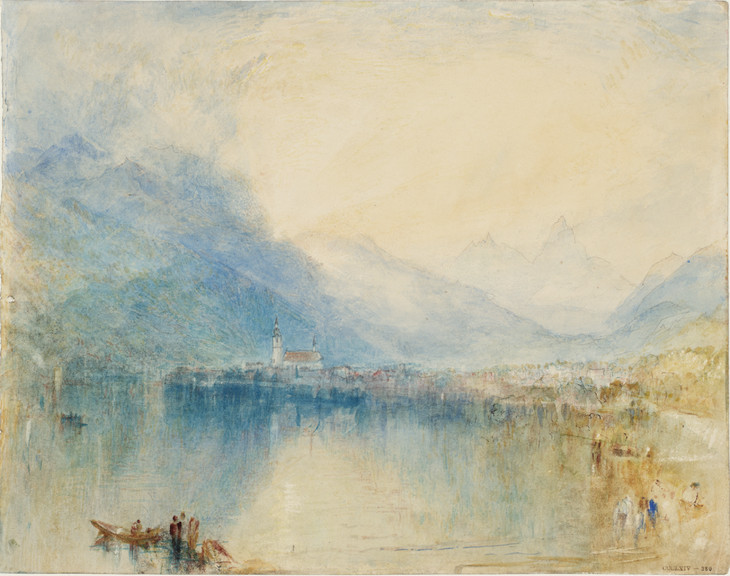
Joseph Mallord William Turner 1775–1851
Arth, on the Lake of Zug. Early Morning: Sample Study c.1842–3
Graphite, watercolour and pen on paper
support: 228 x 290 mm
Tate D36129
Accepted by the nation as part of the Turner Bequest 1856
Joseph Mallord William Turner
Arth, on the Lake of Zug. Early Morning: Sample Study c.1842–3
Tate D36129
Makes ten sample watercolours for his Thomas Griffith to show to clients.
August–September: visits Switzerland, the St Gotthard Pass, Bellinzona and Como.
1843
Exhibits six oils at the Royal Academy.
Makes ten samples for Griffith, who obtains six commissions.
May: first volume of Ruskin’s Modern Painters published, praising Turner
Summer: visits Switzerland.
1844
Exhibits seven oils at the Royal Academy.
Ruskin’s book helps win Turner new admirers and collectors, including Elhanan Bicknell and Joseph Gillott.
24 July: signs a document vesting his land at Twickenham in Trustees for the
establishment of almshouses for the relief and sick and impoverished artists. The document is not validated and the proposal is dropped.
establishment of almshouses for the relief and sick and impoverished artists. The document is not validated and the proposal is dropped.
Late summer: last visit to Swizerland.
8 October: witnesses King Louis-Philippe of France arrive at Portsmouth on a state visit.
17 October: at dinner with Griffith, thanks Ruskin for his book.
1845
8 February: dines with the Ruskin family at Denmark Hill, on Ruskin’s birthday.
20 February: made Acting President of the Royal Academy during the illness of Martin Archer Shee.
June: Shee resigns and Turner is reappointed to December 1846.
Exhibits six oils at the Royal Academy.
Makes two last visits to the Continent, to the French Channel coast, the second
to Dieppe and Picardy when he visits Louis-Philippe at Eu.
to Dieppe and Picardy when he visits Louis-Philippe at Eu.
Following various illnesses, Turner’s health breaks down this year.
1846
Exhibits one oil at the British Institution and six at the Royal Academy.
February: attends Ruskin’s birthday party.
His health still declining, he moves with Mrs Booth and her son Daniel Pound
to 6 Davis Place, Cremorne Road, Chelsea, leaving his decaying London house
and gallery in the care of his housekeeper.
to 6 Davis Place, Cremorne Road, Chelsea, leaving his decaying London house
and gallery in the care of his housekeeper.
29 August: makes another codicil (later revoked) to his will on the care of his pictures.
30 December: last meeting of Academy Council as Deputy President.
1847
Exhibits one (heavily reworked) oil at the Royal Academy.
Health now failing badly.
1848
No exhibits this year, the first time since 1824.
Hires a studio assistant, Francis Sherrell.
2 August: makes new codicils to his will in respect of a Bequest, a ‘Turner’s Gallery’ at the National Gallery and a display of ‘finished pictures’, changing every two years.
1849
1 February: revokes the 1846 codicil to his will, and requires that if the National Gallery does not comply with its terms within ten years after his death, his pictures are to be exhibited free at Queen Anne Street up to two years before its lease expired, and then sold for charity; he adds some personal legacies.
Presumably too ill, and pleading ‘a peculiar inconvenience this year’, he declines an offer from the Society of Arts of a retrospective exhibition.
Exhibits two earlier or repainted oils at the Royal Academy.
Earlier works are exhibited at the British Institution and Royal Scottish Academy.
1850
Exhibits four oils (his last) at the Royal Academy.
Exhibits four oils (his last) at the Royal Academy.
Earlier works are exhibited at the Society of Painters in Water-Colours and the Liverpool Academy, lent by their owners.
1851
Last appearances at the Royal Academy, at Varnishing Days, private view and (7 May) dinner at the Royal Academy Club.
Earlier works are exhibited at the Royal Scottish Academy, lent by their Owners.
By October is bed-bound at Davis Place, attended by doctors and cared for by Mrs Booth.
19 December: 10 a.m., he dies at Davis Place.
His body is taken to Queen Anne Street where it is placed in Turner’s Gallery.
30 December: he is buried in the crypt of St Paul’s Cathedral.
How to cite
David Blayney Brown, ‘Chronology’, December 2012, in David Blayney Brown (ed.), J.M.W. Turner: Sketchbooks, Drawings and Watercolours, Tate Research Publication, December 2012, https://www

